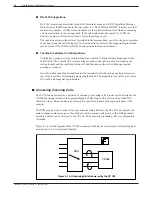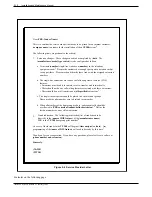
HOW THE VP 300 WORKS WITH THE PHONE SYSTEM
■
Interfaced Installations
Each VP 300 port is connected to a 2500-type single-line, touchtone PBX extension. A 25-pair cable
connects the VP 300 line card to the PBX extension. A PBX extension connected to a VP 300 port is
referred to as port extension.
In order for the VP 300 to extend calls correctly, each port extension must be configured in the PBX to
receive calls, place them on hold, initiate, transfer, and reconnect calls.
A VP 300 port is in use during the entire time it takes to answer a call, dial the extension the caller
entered, and connect the caller to the requested extension. When the called party answers, the VP 300
connects the caller to that extension and drops out of the connection. The VP 300 port is then free to
handle another call. When the called extension is busy or does not answer, the VP 300 port remains
occupied while calling another extension or taking a message. A VP 300 port is in use when
employees are listening to or sending messages.
Port extensions answering with the same company greeting and answering mode are placed in a
hunting arrangement within the PBX. The hunt group may be circular or linear (terminal) according to
the requirements of each particular PBX. This assures that callers are answered by the first available
port.
The mode (AX, CX, or MX) of the VP 300 port determines how calls are answered by the VP 300.
Refer to the Configuration manual – SLOTS.
■
Integrated Installations
Different methods are used to integrate a telephone system with the VP 300. In some cases, a
combination of these methods may be used for full integration.
Integration is the ability of the telephone system, when the call is not answered by the VP 300, to route
or forward a call with information that identifies the extension number the call was intended for, and in
some cases, the extension number of the person initiating the call.
■
In-band Integration
In-band integration is the ability for a telephone system to send DTMF tones that identify the
extension number for a forwarded call to the port extension answering the call. In-band signalling
may include the condition (busy, ring-no-answer, or direct) for the call. In certain installations,
DTMF tones may be used to turn ON or OFF message waiting indicators to indicate when a
mailbox has new messages.
Toshiba VP Systems Release 6.1 February, 1993
PREPARING THE PHONE SYSTEM
2-1
2.1
Summary of Contents for VP 300
Page 2: ......
Page 10: ......
Page 14: ......
Page 20: ...Toshiba VP Systems Release 7 1 July 1994 ...
Page 52: ...Toshiba VP Systems Release 6 1 February 1993 2 14 Installation and Maintenance Manual ...
Page 56: ...Toshiba VP Systems Release 7 1 July 1994 ...
Page 146: ......
Page 312: ...Toshiba VP Systems Release 7 1 July 1994 ...
Page 314: ......
Page 444: ......
Page 496: ......
Page 542: ......
Page 598: ...Toshiba VP Systems Release 6 1 February 1993 ...
Page 600: ...Toshiba VP Systems Release 6 1 February 1993 ...
















































